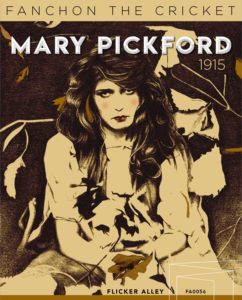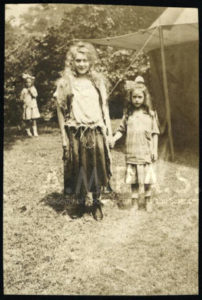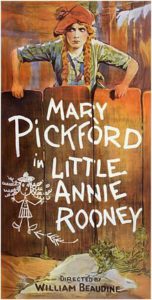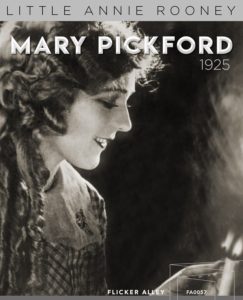With all the actual criminal offenses occurring around the world I struggle with labeling this as criminal, but, it is criminal how difficult it is to see films with, and from, Mary Pickford. On Amazon, there are two regular priced blu-rays, one horribly overpriced and out of print. On DVD there are a handful, but I wouldn’t vouch for the releasing studios. Amazon has a few streaming. Mary Pickford was involved in about 214 films, short and long. Do you know how many Chaplin films I have on disc at home? All but one.
I understand that, in the early days of film much of the releases were assumed to be disposable. Much of this is covered in the delightful Dawson City film. But Pickford was the founder of two movie studios, including United Artist, and is the second recipient of the Best Actress Academy Award. So, I wish it didn’t take this long, and hope that there are many more to come, but I am thankful that Flicker Alley has stepped up to the plate.
You have a chance, right now (11/16/2018) to get these two films on sale for $29.95 over at FlickerAlley.com.
Fanchon the Cricket
Director: James Kirkwood

Screenplay: James Kirkwood and Frances Marion
Minutes: 115
Year: 1915
Score: 6.15
Release: Flicker Alley
From FlickerAlley.com:
Fanchon the Cricket based on an “adult fairy tale” by George Sand, stars Mary Pickford as the title character, a strong-willed waif ostracized by “acceptable society” until she shows them the power of love and understanding. Directed by James Kirkwood and boasting exquisite cinematography by Edward Wynard, Fanchon the Cricket was filmed on location in Delaware Gap, Pennsylvania. A natural, sensual and uninhibited Pickford breaks through today’s stereotype of her as “the girl with the curls.” It is also the only surviving film in which both Jack and Lottie Pickford appear with their sister.
Once believed to be a lost film, Fanchon the Cricket restoration is the result of a unique international collaboration between the Mary Pickford Foundation, the Cinémathèque Française and the British Film Institute. A new negative and 35mm prints were created from the restored digital version and the Mary Pickford Foundation paired the film with a new, original score by Julian Ducatenzeiler and Andy Gladbach.
Okay, first I want to give cover my two issues. One, while delightful, the score is a little distracting. It sounds is like a new-wave / post-punk score. I am used to, either, a piano, organ, symphonic, so this could easily be on me and I won’t make bones about it, just be ready to be a bit distracted. Again, not bad, just different. The other is the lack of special features. I had to go back several years of releases from Flicker Alley to find a bare bones disc, so it is very uncommon. But, this makes $39.95 a tight pill to swallow.
 So, what does this have for the hardcore silent film hoarders? One of the absolute finest restorations I think I have seen. Let me qualify, there are thousands of amazing restorations out there and I don’t think it is fair to compare this to something like the Apu Trilogy which was re-birthed like a phoenix from the ashes. What elevates Fanchon the Cricket is that it is 103 years old and looked like it was photographed yesterday. There are a few instances of gate hairs and top to bottom scratches, but these typically exist after most restorations, so I can look beyond that. I am talking about the shimmering creek water, I am talking about detail in blades of grass. It is something to behold.
So, what does this have for the hardcore silent film hoarders? One of the absolute finest restorations I think I have seen. Let me qualify, there are thousands of amazing restorations out there and I don’t think it is fair to compare this to something like the Apu Trilogy which was re-birthed like a phoenix from the ashes. What elevates Fanchon the Cricket is that it is 103 years old and looked like it was photographed yesterday. There are a few instances of gate hairs and top to bottom scratches, but these typically exist after most restorations, so I can look beyond that. I am talking about the shimmering creek water, I am talking about detail in blades of grass. It is something to behold.
There is an intertitle opening the film explaining that Mary was interested in making sure that her films were taken care of after her life ended; they are her legacy after all. She was unhappy that this film had two missing reels which were only recently rediscovered. The work that the Mary Pickford Foundation and the Cinémathèque Française putting this together is a testament to the modern desire to make available these classic films.
So, what could that have done to increase the value of this package? Pickford was in hundreds of short films and I think if they could have secured the rights to two or three of them to include here I think it would help. But rights are rights and I’m sure that Flicker Alley would have if they could have. Cinémathèque Française could have put together a restoration demo reel, those kill me every time. Another other option would have been to pair it with the next release in a double feature set, I don’t know. If you are an intense movie lover, then you are probably going to want to pick this up otherwise it may be too niche of a release.
Director: 6 – Cinematography: 10 – Edit: 6 – Parity: 3 – Main performance: 8 – Else performance: 1 – Score: 7 – Sound: NA – Story: 6 – Script: 5 – Effects: NA – Design: 6 – Costumes: 9 – Keeps interest: 8 – Lasting: 5
Little Annie Rooney
Screenplay: Mary Pickford, Hope Loring, and Louis Lighton
Producer: Mary Pickford
Minutes: 95
Year: 1925
Score: 6.21
Release: Flicker Alley
From FlickerAlley.com:
Mary Pickford plays a “tomboy of the tenements” in this comedy drama, which she also wrote. Filmed over ten weeks, Little Annie Rooney was shot entirely on a set created by art director John D. Schulze at the Pickford Fairbanks Studio. Co-starring William Haines and a wide-ranging, multi-ethnic cast, Little Annie Rooney met with huge critical and commercial success upon its original release, proving fans and critics alike wanted the then-33-year-old Mary to stay a child forever.
Created from the original tinted nitrate print in Mary Pickford’s personal collection at the Library of Congress, Little Annie Rooney was preserved photochemically by the Academy of Motion Picture Arts and Sciences Film Archive. A new 35mm preservation master was then scanned at 4K high definition so that the Mary Pickford Foundation, in cooperation with AMPAS, could create a digital version to perfectly match the original nitrate tints and tones. The Mary Pickford Foundation commissioned Andy Gladbach to compose a new, original soundtrack performed by a 12-piece orchestra including three percussionists.
Little Annie Rooney is a weird movie. Weird in a creepy way. At this point in her life Pickford is 33 years old, the character, Little Annie Rooney, is 16 and she falls head over heels in love with Joe, a character who is probably in his early 20s (and doesn’t try hard to spurn her advance), the actor William Haines, would have been 31. The opening scene has 33-year-old Pickford is a well-choreographed gangland (kids) rock and garbage fight. The kids are played by obvious kids. Everything looked odd. And at this point I made the mistake of thinking I was in for a Chaplin-esque romp.
 Boy was I ever wrong. There is some definite drama laced throughout which defies the opening scenes, it puts Pickford, who wrote the story and produced the film, on par with her United Artist partner Charlie Chaplin, whose The Gold Rush came out the same year. There are many American silent features which I still need to watch to have a better idea of the content trajectory of sprinkling drama into their comedic recipes. Either way I am glad to have watched this one.
Boy was I ever wrong. There is some definite drama laced throughout which defies the opening scenes, it puts Pickford, who wrote the story and produced the film, on par with her United Artist partner Charlie Chaplin, whose The Gold Rush came out the same year. There are many American silent features which I still need to watch to have a better idea of the content trajectory of sprinkling drama into their comedic recipes. Either way I am glad to have watched this one.
The release suffers the same aliment of Fanchon the Cricket. While it does have one featurette, which is interesting, it still feels a little empty. (Again, compared only to other Flicker Alley releases). With the same $39.95 price tag I don’t see this jumping off the shelf. The restoration is incredibly strong, but I don’t think it is enough. I didn’t recommend this with the other release because it didn’t feel like the right place, but I think this would be a good disc to include a short documentary about Mary Pickford, like the documentary in Clara Bow from their Children of Divorce release.
It’s a very good movie and deserves to be held in the same regard as other silent United Artist releases.
Special Features:
- Feature on the young composer Andy Gladbach
Director: 7 – Cinematography: 7 – Edit: 5 – Parity: 5 – Main performance: 7 – Else performance: 3 – Score: 8 – Sound: NA – Story: 5 – Script: 7 – Effects: 6 – Design: 6 – Costumes: 8 – Keeps interest: 8 – Lasting: 5
